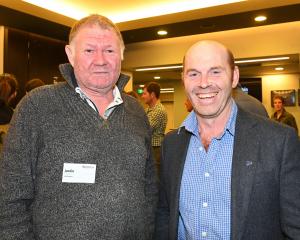
Botry-Zen chief executive John Scandrett began the day, continuing in the same vein as businesses that made submissions earlier in the week by claiming the plan change may force his business to leave Dunedin.
He said 83% of the building his business occupied at 25 Willis St would be taken for the proposed Fairley St walkway.
"In plain terms, I must table the fact that our company could not continue to operate at the present location were we to see a 9m-wide pathway cut through the heart of our factory."
Other businesses during the day expressed similar concerns, and it was suggested the council provide financial support for relocation if it went ahead with the plan change.
The hearing was also told about the cold, wind, and all-day frost that blighted Fryatt St.
Otago Regional Council counsel Alastair Logan told the hearing the local authority supported the plan change and the harbourside vision, but did not want to be drawn into an argument about whether the project be limited to stage one - the redevelopment of the area immediately adjacent to the Steamer Basin.
Also for the council, Megan Justice argued commercial office activity be allowed in the southern part of the character area, something the city council planner had rejected.
That would attract people to the area during the week, she said.
The council wanted noise insulation requirements to be extended to cover all activities in the harbourside zone to mitigate reverse sensitivity.
It also suggested car parking provisions be reduced.
For the Institution of Professional Engineers New Zealand engineering heritage group, Darrel Robinson said the plan change was a bold idea.
But reuse of heritage buildings was "absolutely essential", and a special set of rules or greater flexibility during resource consent hearings was necessary to promote that.
Transit New Zealand acting regional manager Bruce Richards said the proposed upgrade of the harbour arterial route was a significant component of the roading network, and the route could one day be a state highway.
Transit was concerned about existing and future property access to the existing harbour arterial route.
Mr Richards said he wanted a rule that prohibited direct property access on to the route.
Neville Marquet, counsel for Tim Barnett, argued the plan change would completely disenfranchise his client.
Mr Barnett, a Dunedin property developer, was this month given consent to build a three-storeyed office and residential building at 41 Wharf St.
But the property has been identified by the council as suitable for a road linking Wharf St with a new on-ramp to the nearby overbridge and is subject to a notice of requirement. Mr Marquet said the proposed plan change would allow only recreational activity on the land.
"In my submission, this is a worthless right."
It would reduce the value of the land if it was acquired by the council, he said.
He questioned whether the land was really wanted for a road, given the council's notice of requirement referred to increased open space in the area.
"In my submission this is the real purpose for serving the requirement.
"The designated public work is merely a guise for the acquisition of additional open space."
Mr Marquet said there was no traffic benefit from shifting the off-ramp, and if the road was being moved just to create open space it would be the most expensive open space in New Zealand.
Traffic engineer David Gamble told the committee aspects of the council's option for the off-ramp were "fatally flawed", meaning it could not be built.












